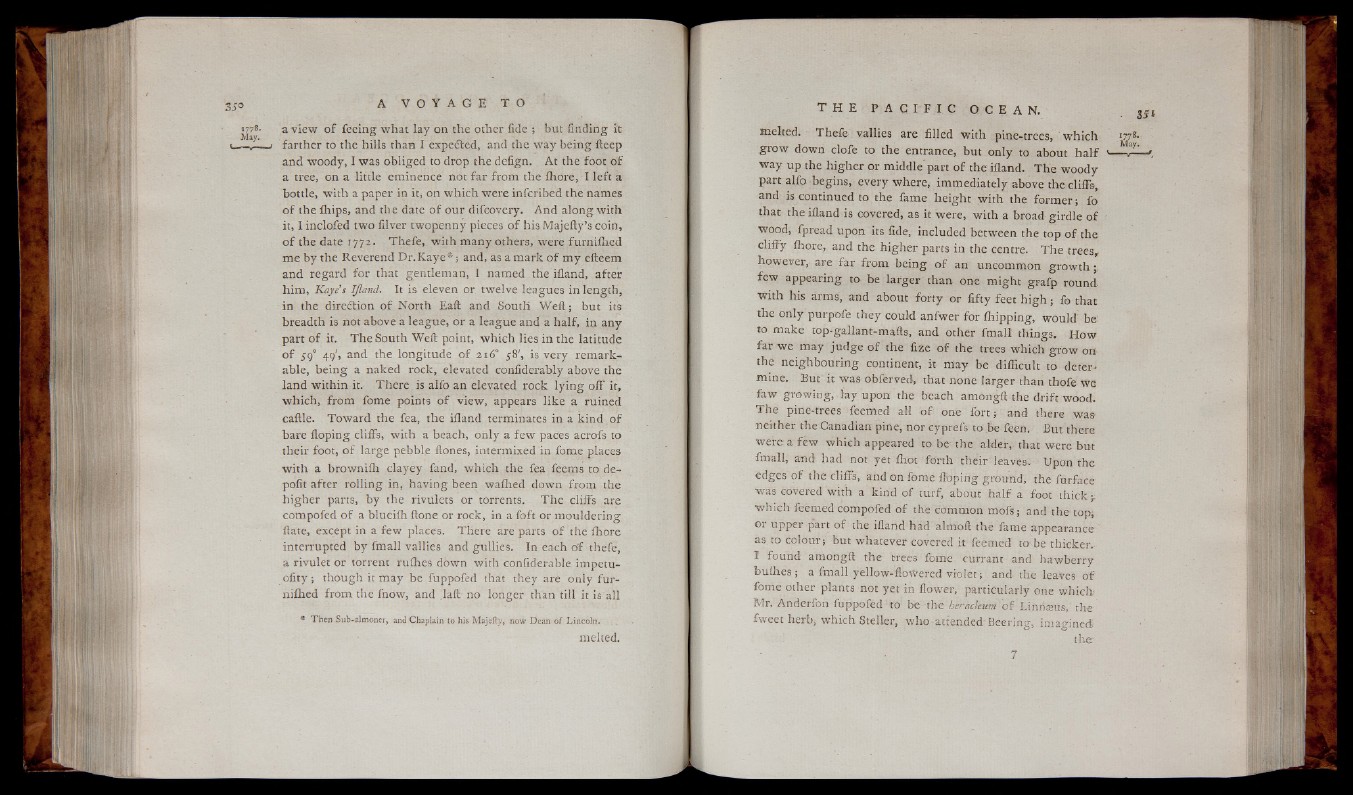
1778. a view o f feeing what la y on the other fide ; but finding it
<_— 1 farther to the hills than I expedted, and the w ay being fteep
and woody, I was obliged to drop the defign. At the foot o f
a tree, on a little eminence not fa r from the fhore, I left a
bottle, with a paper in it* on w hich w ere infcribed the names
o f the fhips, and the date o f our difcovery. And along w ith
it, I inclofed two filver twopenny pieces o f his Majefty’s coin,
o f the date 1772. Thefe, with many others, were furniihed
me by the Reverend D r .K a y e * ; and, as a mark o f m y efteem
and regard for that gentleman, I named the ifland, after
him, Kaye’s IJland. It is eleven or twelve leagues in length,
in the direition o f North Eaft and South W e ft ; but its
breadth is not above a league, or a league and a half, in any
part o f it. The South Weft point, which lies in the latitude
o f 590 49', and the longitude o f 216° 48', is ve ry remarkable,
b e in g a naked rock, elevated confiderably above the
land within it. There is alfo an elevated rock ly in g o ff it,
which, from fome points o f view, appears lik e a ruined
caftle. Toward the fea, the ifland terminates in a kind o f
bare Hoping cliffs, with a beach, only a few paces acrofs to
their foot, o f large pebble ftones, intermixed in fome places
w ith a browniih clayey fand, w hich the fea feems to de-
pofit after rolling in, having been waflied down from the
higher parts, by the rivulets or torrents. T he cliffs are
compofed o f a blueiih ftone or rock, in a foft or mouldering
Hate, except in a few places. There are parts o f the fhore
interrupted by fmall vallies and gullies. In each Of thefe,
a rivulet or torrent ruihes dbwn with confiderable impetu-
ofity ; though it may be fuppofed that they are only fu r niihed
from the fnow, and .laft no longer than till it is all
* Th en Sub-almoner, and Chaplain to his Majefty, now Dean o f Lincoln.
melted.
melted. T h e fe vallies are filled with pine-trees, w h ich
g row down clofe to the entrance, but only to about h a lf
w a y up the highe r or middle part o f the ifland. T he woody
part alia-begins,- every where, immediately above the cliffs,
and is continued to the fame height w ith the fo rm e r ; fo
that the ifland is covered, as it were, with a broad girdle o f
wood, fpread upon its fide, included between the top o f the
cliffy fhore, and the highe r parts in the centre. T he trees,
however, are far from being o f an uncommon growth
few appearing to be la rg e r than one might grafp round
w ith his arms, and about forty or fifty feet h ig h ; fo that
the only purpofe they could anfwer for fhipping, would be
to make top-gallant-mafts, and other fmall things. How
fa r we may ju d g e o f the fize o f the trees which grow on
the neigh b ourin g continent, it may be difficult to deter-
mine. But it was obferved, that none larger than thofe we
faw growin g, lay upon the beach amongft the drift wood.
T h e pine-trees feemed all o f one fo r t ; and there was
neither the Canadian pine, nor eyprefs to be feen. But there
were a few which appeared to b e the alder, that were but
fmall, and had not yet fh'ot forth their leaves- Upon the
edges o f the cliffs, and on fome floping ground, the furface
was covered with a kind o f turf, about h a lf a foot th ic k ;
w hich feemed compofed o f the common mofs; and the top;
or upper part o f the ifland had almoft the fame appearance
as to colour; but whatever covered it feemed to be thicker..
I found amongft the trees fome currant and hawberry
buihes ; a fmall yellow-flowered v io le t; and the leaves o f
fome other plants not yet in flower, particularly one which
Mr, Anderfon fuppofed to be the heracleum o f Liniiasus, the
fweet herb, which Steller, who attended'Beering, imagined
th e